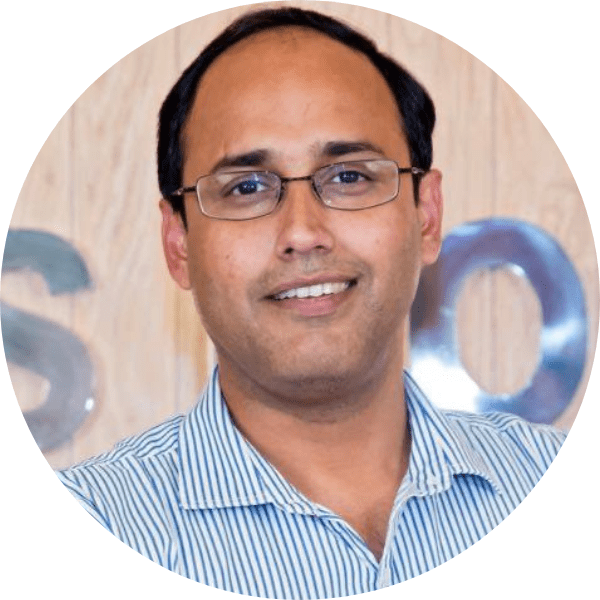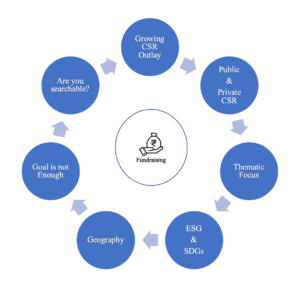6 min read
Fundraising for any organization is a difficult task but for the non-government organizations (NGOs) it is the core of its survival and growth. Funding sources decide the scale & sustainability of NGO’s community development projects, systems they can build, talent they can afford to hire and most importantly the health of the organization – what happens if funders decide to leave?
The era of long-term institutional funding through bilateral agencies has been replaced by private & public corporate social responsibility (CSR) grants after passing of the CSR Act, 2013. Therefore, to understand the evolving CSR ecosystem better and align organization’s fundraising systems become very important to increase the odds of success. This article is an attempt to gather a few tested ideas that might help readers, especially the new NGOs in sharpening their fundraising efforts. Another equally important option is individual/retail fundraising which this article is not getting into.
Target the growing CSR outlay
India’s yearly CSR spend increased from ₹14,343 crore in FY-17 to ₹24,860 crore in FY-20. This growth trend got hit during FY-21 due to the pandemic when the spend decreased by ₹ 4500 crore. Despite this fall, big companies spent almost the same amount as compared to the previous year. The contribution to Prime Minister National Relief Fund also increased by 82 per cent from ₹ 797 crore (in FY-20) to ₹ 1453 crore (FY-21). Overall India’s CSR outlay can be estimated at ₹ 25000 crore and it will further increase, as the nation strives to become a five trillion economy. Therefore, focusing on this growing outlay to match NGOs’ project fund requirement is a practical thing to do.
Understand the public & private CSR ecosystem
Out of the total CSR spend, 20 per cent expenditure is by public sector units (PSUs) and 80 per cent by non-PSUs (Pvt. CSRs). This trend remained the same despite overall decrease in spend in FY-2021. Hence while planning institutional fundraising, a better understanding of PSU and private CSR helps in targeting the right organizations. PSUs follow government guidelines for all its project executions. For example, if PSUs like Govt. Departments sponsor any healthcare training program, centres need to follow all the health sector council guidelines such as certification of centers, certification of trainers, assessment of students etc. On the other hand in case of innovative programs such as building future skills etc. chances are high that Pvt. CSR will be the right fit, who can provide more flexibility to innovate as long as proposed projects are aligned to schedule VII activities as prescribed in the CSR Act.
Align with the thematic focus
Majority of CSR spends are in the areas of Education, Differently Abled & Livelihoods (38 per cent), Health and Sanitation (27 per cent ), Rural Development (9 per cent ) & Environment (7 per cent). If NGOs’ projects are aligned accordingly, it will help in approaching more organizations. At the same time only focusing on these themes alone isn’t enough and CSRs and NGOs should penetrate more into Tier 2 and 3 cities where the requirements are more.
Align with ESG Goal & SDGs
As per SEBI’s disclosure requirements under business responsibility and sustainability covering environmental, social and governance (ESG) parameters (which came last year for 1000 listed companies), companies look for opportunities to align their CSR activities to environmental and social goals for wider alignment with their ESG goals and united nations’ sustainable development goals (SDGs). Better the alignment, higher are the chances of fundraising success.
Select the right geographies
Top 10 states where CSR spend is high (approx. ₹ 9000 crore) remained the same during pre-pandemic and pandemic phases. Hence it increases the odds of success if an NGO is working in Maharashtra, Gujarat, Karnataka, Delhi, Tamil Nadu, Uttar Pradesh, Andhra Pradesh, Odisha, Rajasthan and Haryana. Once a relationship is built with donors, then they can be persuaded to scale-up initiatives in other states, tier 1 and tier 2 cities, smaller towns and aspirational districts.
Goal is not enough
Having an annual fundraising goal for the organization or fund raising department is not enough. NGOs should also have a strategy and execution plan on how the fundraising goal will be accomplished. For example at Dr. Reddy’s Foundation, we follow a strategy of Deliver, Connect and Scan. It means that we need to execute our projects well and deliver on the project outcomes so that the current partners keep supporting the project, connect with new partners to share our models for further scale-up and, scan the Request for Proposals (RFPs) on regular basis which are usually published in the public domain and keep applying for the relevant ones. Additionally once the annual fundraising goal is agreed we try to break the goal into (a) organizations to be targeted (b) total numbers of proposals to be submitted in a year (c) deciding the scale-up platform – public or Pvt. CSR (d) measuring the efforts made on a quarterly basis and (e) most importantly if any proposal is not considered, requesting concerned organizations to share their feedback why they did not support the initiative. Such inputs can be very helpful for future proposal submissions.
If you are not searchable, you do not exist
Social media presence, quality of website, published annual & project assessment reports, feedback of past & existing partners play a very important role in getting new grants. Companies look for trustworthy organizations, which have strong governance systems and good execution track record. Therefore, for new NGOs this aspect requires disciplined efforts until they are known for their quality work. In the past 25 years in DRF we got an opportunity to work with more than 70 national and international organizations including state and central govt. ministries and tried to convert most of them as long- term partners by focussing on quality execution. These long term partners also helped us to connect with more partners. There were times when execution of projects got delayed due to various operational challenges on the ground especially when we tried new pilots or during the pandemic, but timely and transparent communication built the trust further.
Conclusion
Last but not the least, we can’t ignore the importance of luck. We had many such opportunities in the past when we received letters from government departments or e-mails from CSR teams inviting us to discuss proposals when we were least expecting it. There are also instances when we had to do follow-up for more than 2 years and still proposals did not go through. The Nobel laureate Daniel Kahneman writes in his book (Thinking Fast and Slow) that ‘success = talent + luck’ and ‘great success = a little more talent + a lot of luck’. As we do not have control over luck we can focus on developing our fundraising skills by understanding the evolving CSR ecosystem better, having a realistic goal, a clear strategy and a strong execution plan to increase the chances of success.



















